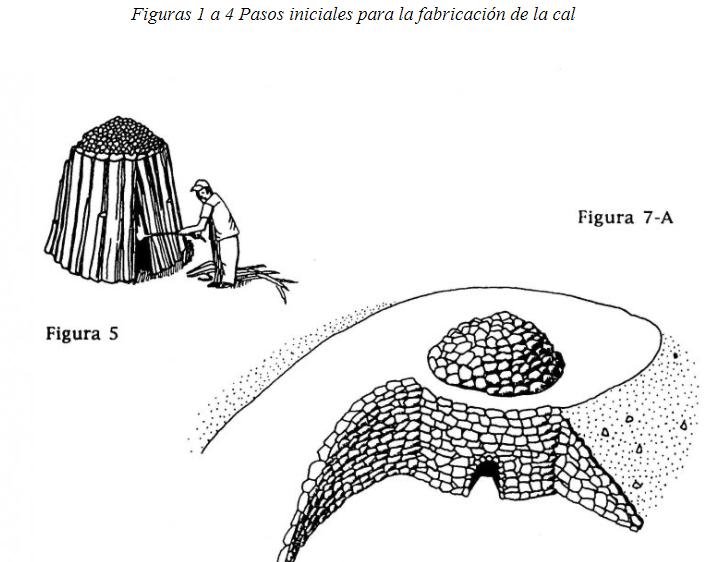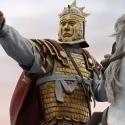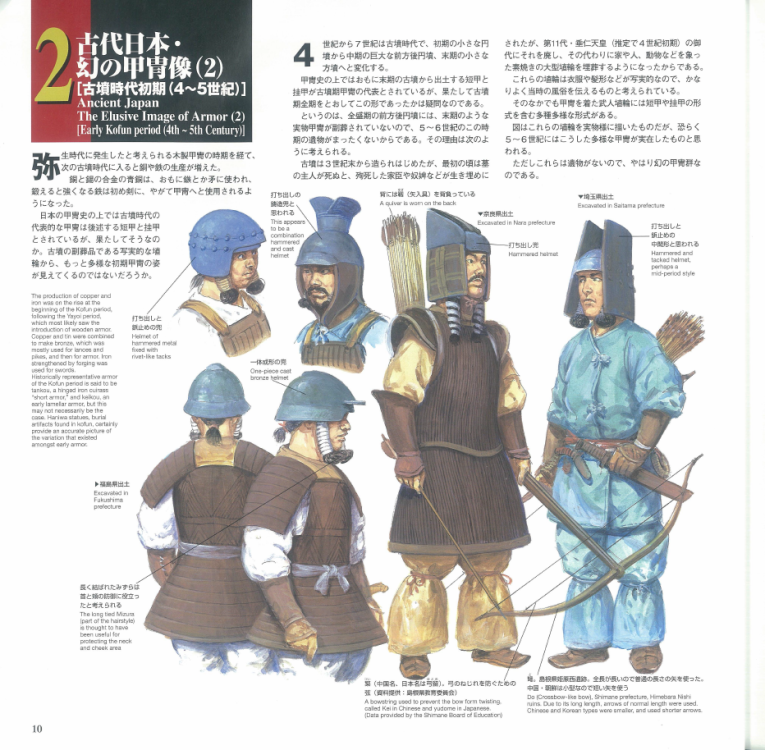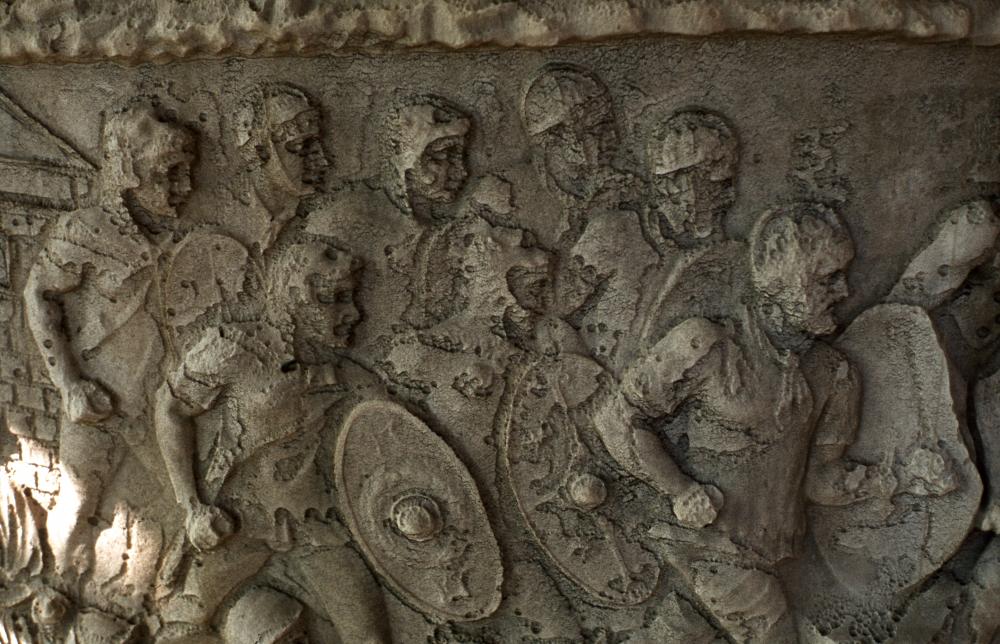-
Posts
413 -
Joined
-
Last visited
-
Days Won
3
Posts posted by Ultimate Aurelian
-
-
A picture i found online, labelled as ''Gallic warriors in the Alps''.

Not sure how accurate it is, the winged helmet looks like something from a 19th century reconstruction.
-
-
On 11/09/2022 at 11:44 AM, AIEND said:
There are seventy-two chariots named Wuyi Daju, Spear and Halberd, and the two wings are guarded by skilled and brave warriors who use strong crossbows, spears and halberds. Its wheels are five feet high and are equipped with a repeating crossbow fired from a winch, which can be used to break through fortified formations and defeat powerful enemies.
There are one hundred and forty chariots called "Little Sails and Fuxu", and they are equipped with repeated crossbows fired by winches. This vehicle is equipped with a wheel, which can be used to break through the fortress and defeat the strong enemy.
I remeber reading something about unmanned charriots who fired crossbows on their own years ago.
I tried looking for the source, and could only find this article.
http://eskify.com/10-unbelievable-ancient-weapons/
QuoteFire Horse Chariots
Unmanned Chariots armed with automatic crossbows, pulled by horses with burning tails. This ancient weapon would have been terrifying for the soldiers who saw it coming/ In a time where superstitious beliefs were widespread a chariot that was being driven by horses coated in fire, and guns fired by no one, could make people think they were being attacked by ghosts or demons. In 180 ad there was large rebellion against Yang Shuan. Yang Shuan was completely outnumbered and needed to come with something to break up the army, without costing him any lives. He thought of creating crossbows that could fire on their own, and attaching them to chariots. The chariots would be pulled by horses who would be pointed in the direction of the enemy, and have their tails set on fire. -
In the future there could also be Cimbrians, who fit more neatly in the part 1 timeline.
They would be a bit similar to Suebi, but more nomadic and maybe a celtic influenced roster with more armoured units.
-
 2
2
-
-
On 17/10/2022 at 2:23 PM, Stan` said:
I thought suebians should go in the empires besieged mod?
From the heroes they cover from the Gallic wars to the Marcommanic war.
So i guess they are kind of halfway between part 1 and part 2?
-
On 15/01/2017 at 1:47 AM, Sundiata said:
Kush and the Persians
By 609 BC, The Neo-Assyrian Empire had collapsed, and was absorbed by the Achaemenid Persian Empire under Cyrus the Great. His successor, Cambyses II, successfully conquered Egypt in 525 BC, ending the Saite Dynasty, after which he attempted the conquest of Kush
I think he is talking about the first post
-
1 hour ago, wowgetoffyourcellphone said:
If we had officers instead of heroes, that'd be a good choice. You could rank up your Tribune to Praetor, then to Consul.
Maybe for battalions.
Maybe could do like the Hyrule mod and have both heroes and officer units.
-
 1
1
-
-
19 hours ago, Genava55 said:
The crossbow mentioned here may pontentially fit the Yayoi period, the dating is not very clear.
http://gunbai-militaryhistory.blogspot.com/2019/01/dokyu-japanese-crossbow.html
This link mentions something about a crossbow trigger possibly dating to that period as well.
-
 2
2
-
 1
1
-
-
https://people.ucalgary.ca/~vandersp/Courses/texts/prisfr8.html
This has some interesting descriptions of Atilla's capital, could be useful for Wonder
QuoteHaving waited for some time until Attila advanced in front of us, we proceeded, and having crossed some rivers we arrived at a large village, where Attila's house was said to be more splendid than his residences in other places. It was made of polished boards, and surrounded with a wooden enclosure, designed, not for protection, but for appearance. The house of Onegesius was second to the king's in splendour, and was also encircled with a wooden enclosure, but it was not adorned with towers like that of the king. Not far from the enclosure was a large bath which Onegesius--who was the second in power among the Scythians-- built, having transported the stones from Pannonia; for the barbarians in this district had no stones or trees, but used imported material. The builder of the bath was a captive from Sirmium, who expected to win his freedom as payment for making the bath. But he was disappointed, and greater trouble befell him than mere captivity among the Scythians, for Onegesius appointed him bathman, and he used to minister to him and his family when they bathed.
QuoteThe next day I entered the enclosure of Attila's palace, bearing gifts to his wife, whose name was Kreka. She had three sons, of whom the eldest governed the Acatiri and the other nations who dwell in Pontic Scythia. Within the enclosure were numerous buildings, some of carved boards beautifully fitted together, others of straight, fastened on round wooden blocks which rose to a moderate height from the ground. Attila's wife lived here, and, having been admitted by the barbarians at the door, I found her reclining on a soft couch. The floor of the room was covered with woollen mats for walking on. A number of servants stood round her, and maids sitting on the floor in front of her embroidered with colours linen cloths intended to be placed over the Scythian dress for ornament.
Also some descriptions of boats being used to cross rivers within the Huns' territory (They might need a navy for balance reasons)
QuoteAt the river we were received by barbarian ferrymen, who rowed us across the river in boats made by themselves out of single trees hewn and hollowed. These preparations had not been made for our sake, but to convey across a company of Huns; for Attila pretended that he wished to hunt in Roman territory, but his intent was really hostile, because all the deserters had not been given up to him. Having crossed the Danube, and proceeded with the barbarians about seventy stadia, we were compelled to wait in a certain plain, that Edecon and his party might go on in front and inform Attila of our arrival.
QuoteWe proceeded along a level road in a plain and met with navigable rivers--of which the greatest, next to the Danube, are the Drecon, Tigas, and Tiphesas--which we crossed in the Monoxyles, boats made of one piece, used by the dwellers on the banks: the smaller rivers we traversed on rafts which the barbarians carry about with them on carts, for the purpose of crossing morasses. In the villages we were supplied with food--millet instead of corn, and mead, as the natives call it, instead of wine.
-
It's interesting that he says helmets were even rarer than armor.
In most ancient armies it was the opposite; the helmet was the priority and anyone with a breasplate usually could afford one as well.
They did remove the cheekguards from imported helmets (Making them lighter in exchange for less protection).
So possibly there were a few who could afford helmets, but did not bother with them because they thought they were too cumbersome.
-
 2
2
-
-
2 hours ago, Lion.Kanzen said:
Apparently it is a type of shield associated with the Visigoths
But there is not really hard evidence for it, and it might just be an incorrect depiction of an hexagonal shield.
http://theminiaturespage.com/boards/msg.mv?id=185238
http://www.slitherine.com/forum/viewtopic.php?t=13673
https://balagan.info/gothic-shield-shapes-there-is-no-such-thing-as-a-gothic-coffin-shield
-
 2
2
-
-
5 hours ago, Genava55 said:
But it is plausible the Germanic auxiliaries at this time got their helmets from the Sarmatians or the Dacians
It seems a lot of Germanic armor was actually made by Celts and Romans (And acquired through trade or looting); it makes sense they would do a similar thing with their other neighbours.
Some years before the Dacian wars; Pannonia was invaded by an alliance of Dacians, Suebians and Sarmatians.
It is likely there was some degree of trade and cultural exchange between Germanics and those groups.
-
On 20/08/2019 at 8:06 AM, Genava55 said:
Those helmets are interesting, they remind me of the banded helmets worn by Germanics later in migration period.
Perhaos those were influenced by Roman helmets, or the Auxilia in the picture are using an earlier Germanic helmet?
-
The (in)famous Irish foot cataphracts from the first versions of EB.
https://europabarbarorum.fandom.com/wiki/Dubosaverlacica_(Ebherni_Armoured_Shock_Infantry)
Later removed because they were made up.
-
 1
1
-
-
-
27 minutes ago, Grapjas said:
How so? Wasn't it normal to climb the military rank ladder?
The Extraordinarii were recruited exclusively from Rome's Itallic allies.
So does not make sense as an upgrade for Roman Hastatii.
-
 1
1
-
-
21 minutes ago, Grapjas said:
It makes sense for experienced soldiers to become champions.
This depends on the civ.
It would be weird to turn the Machimoi into Greeks, or Roman Citizens into Extraordinari.
-
 1
1
-
 1
1
-
-
25 minutes ago, PyrrhicVictoryGuy said:
Not that. Citizens of syracuse were never, acording to ancient sources, employed as anything other than heavy infantry and cavalry. The native Sicel and siculian tribes however did.
I think it's possible Hieron sent mercenaries or native levies to Rome considering what you said.
Livy does not say what people these slingers where.
QuoteFor heavy foot and horse, the King (Hieron) knew that the Roman People employed none but Romans and Latins; but amongst the light-armed auxiliaries, he had seen in the camps of the Romans even foreigners; he had therefore sent a thousand archers and slingers, a force well adapted to cope with Moors and Baliares and other tribes that fought with missiles
Polybius describes Peltasts instead of Slingers.
QuoteThey sent also to king Hiero asking for reinforcements, who sent them five hundred Cretan archers and a thousand peltasts.
The confusion could be because they sent slingers with shields.
-
30 minutes ago, PyrrhicVictoryGuy said:
Surely you mean sicilian slingers
Greek colonists in Sicily
-
4 hours ago, Fabius said:
I am certain Romans were not above hiring mercs, I believe in the parthian wars they had balearic slingers already to great effect. This was the Triumvirate era though, but I am certain they would have already been using them prior. .
For the timeframe i think Syracusan slingers would be a better option; they were used by Rome in the Punic and Macedonian Wars.
Or the Numidian slingers and archers from the siege of Numantia.
Some Italic peoples like Ligurians and Picenes used slings; but i am not sure if they fought in the Roman army at the time.
-
 1
1
-
-
does Himiko count -
On 25/01/2022 at 2:02 PM, Nullus said:
It's a pity that no models were made for the Iberians, since they would be the ideal civ for defence-centred differentiation.
Personally i think it should only be avaliable to civs that have artillery.
-
 1
1
-
-
The Pyramid of La Danta, one of the biggest in the world.
https://es.wikipedia.org/wiki/Pirámide_de_La_Danta
-
 2
2
-
-
1 hour ago, Duileoga said:
Good morning or afternoon;
-Yes, I know it @Ultimate Aurelian and that is why I did not include metal ornaments and the oven, it is a lime oven, although I am not 100% sure that it looked like that in the preclassic;
Main Reference;

-But somewhere should the military technologies be developed, in the barracks? If the majority believes that there should not be a mayan smithy(preclassic), I will not oppose it.¡Thanks for the review.!

sorry for the inconvenience*I think the building could still exist, but maybe called something other than blacksmith (Crafstman, armory).
-
 3
3
-










===[TASK]=== Current issues with Celtic units and guideline for the next
in Official tasks
Posted
Is scale armor accurate for Celts?
It is one of the current textures for the Gaul champion swordsman and champion cavalry.